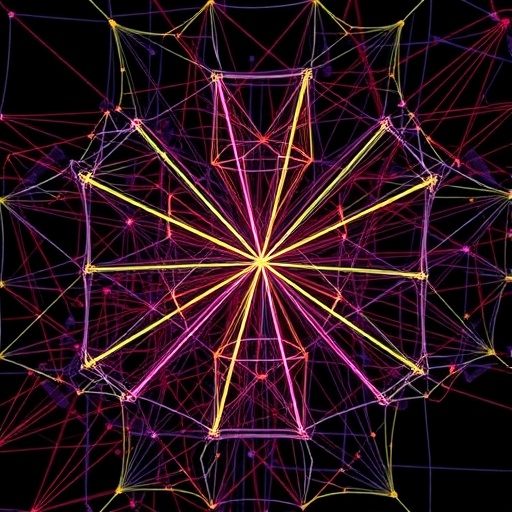In the rapidly evolving landscape of microbiology and computational science, a groundbreaking advance has emerged that promises to revolutionize our understanding of microbial ecosystems. A team of researchers led by Andersen et al. has harnessed the power of graph neural networks (GNNs) to predict complex microbial community structures and their temporal dynamics. This innovative approach combines deep learning with ecological data to unravel the intricate web of microbial relationships over time, providing unprecedented insights into the invisible forces shaping microbial life.
Microbial communities constitute some of the most diverse and ecologically critical systems on Earth, driving essential processes such as nutrient cycling, climate regulation, and human health. Despite their importance, predicting how these communities assemble, function, and evolve has remained a formidable challenge due to the sheer complexity and dynamic nature of microbial interactions. Traditional models often fall short in capturing the nonlinear, high-dimensional dependencies typical of microbial ecosystems, necessitating novel computational paradigms.
Graph neural networks, a class of machine learning models designed to operate on graph-structured data, rise to meet this challenge by incorporating relational information inherent in microbial communities. By representing microbes as nodes and their interactions as edges, GNNs can learn intricate patterns of association and influence, enabling the prediction of community composition and flux through time. This method capitalizes on both the topological features of microbial networks and temporal sequencing data to formulate robust, predictive models.
The study intricately combines longitudinal microbiome datasets with advanced computational architectures. By training the GNN on time-series microbiome data, the researchers achieved models that can predict future microbial community states with high accuracy. Such predictive capability is vital for both ecological conservation and medical applications, where understanding microbial succession can inform strategies for ecosystem restoration or disease prevention.
One hallmark of this approach is its ability to incorporate multiple layers of interaction, including competitive, cooperative, and neutral relationships among microbial taxa. This multidimensional modeling surpasses simpler ecological models that often assume independent or pairwise interactions, offering a more holistic and realistic depiction of microbial ecosystems. The GNN framework effectively captures higher-order dependencies, a feat that has remained elusive in previous computational strategies.
Central to the methodology is the representation of microbial data as graphs that encapsulate diversity, abundance, and spatial distribution. This enables the model to learn not only from the presence of species but also from how their interactions evolve, strengthening its predictive fidelity. The temporal aspect is particularly crucial, as it allows the GNN to map out trajectories of community change rather than static snapshots, a critical advancement for understanding processes like invasion, extinction, and community resilience.
To validate their models, Andersen and colleagues conducted extensive testing using synthetic datasets as well as real-world microbiome samples drawn from various environments. These included soil, marine, and human-associated microbial communities, each presenting unique interaction networks and temporal dynamics. The cross-domain applicability underscores the versatility of GNNs in modeling microbial ecology comprehensively.
The implications of being able to predict microbial community dynamics extend far beyond academic curiosity. For instance, in agriculture, forecasting soil microbiome shifts can inform sustainable farming practices that harness natural microbial functions, reducing reliance on chemical inputs. Similarly, in medicine, anticipating changes in human microbiota can guide personalized interventions to stymie pathogenic outbreaks or promote beneficial microbial consortia.
Importantly, the researchers also highlight the interpretability of their GNN models. Unlike many deep learning architectures criticized as ‘black boxes,’ their approach offers insights into which interactions and species drive community changes. This transparency is essential for biological validation and for scientists aiming to decipher the mechanistic underpinnings of microbial dynamics.
Another remarkable feature of this research is the scalability of the GNN approach. Given the exponential growth of microbial sequencing data, computational models must efficiently process vast datasets without sacrificing predictive power. The study demonstrates that their GNN framework can scale up, handling large datasets while maintaining accuracy, which opens the door to its use in global microbiome initiatives.
Moreover, the integration of this neural network technology with ecological theory promises to foster a new era of predictive ecology. By bridging the gap between data-driven models and classical ecological concepts such as succession and niche theory, this research sets a precedent for future studies aiming to unify empirical observations with computational power.
While the team’s achievements constitute a significant leap forward, they also acknowledge limitations and avenues for future research. For instance, incorporating environmental variables such as pH, temperature, and nutrient levels into the GNN models could further refine predictions. Additionally, expanding the framework to accommodate microbial functional traits and gene expression data could deepen our understanding of the mechanistic bases for community shifts.
This pioneering work also raises exciting possibilities for real-time monitoring and intervention. With the advancement of sensor technologies capable of rapid microbiome sampling, GNN-based predictive systems could be deployed in situ to monitor ecosystem health or human microbiome balance, enabling timely responses to undesirable changes.
In conclusion, Andersen et al. have unveiled a transformative computational strategy that leverages graph neural networks to decode the complexity and temporal variability of microbial communities. Their research not only offers a powerful predictive tool for microbial ecology but also paves the way toward proactive management of these vital ecosystems across natural and human contexts. As microbiome data continues to burgeon, such integrative, dynamic modeling approaches are poised to become indispensable in the quest to comprehend and harness microbial life on Earth.
Subject of Research: Predicting microbial community structure and temporal dynamics using graph neural network models.
Article Title: Predicting microbial community structure and temporal dynamics by using graph neural network models.
Article References:
Andersen, K.S., Zhao, K., Agerskov, A.d.L. et al. Predicting microbial community structure and temporal dynamics by using graph neural network models. Nat Commun 16, 9124 (2025). https://doi.org/10.1038/s41467-025-64175-7
Image Credits: AI Generated




